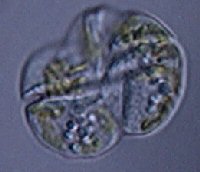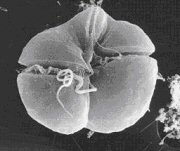Harmful Algal Blooms
Andy Tirpak, Coastal Fisheries Program Specialist
Here at the Texas Parks and Wildlife Department we often receive questions concerning red tides. Today these red tide events are more commonly known in the scientific community as Harmful Algal Blooms or HABs. Harmful algae are microscopic, single-celled plants that live in both fresh and marine waters (golden algal blooms are causing problems in freshwater). These HABs aren’t all that common. In fact, most species of algae or phytoplankton are not harmful and serve as the energy producers at the base of the food web, without which higher life on this planet would not exist.

Red tide is an example of a marine HAB which occurs when either natural or human factors cause a rapid increase in the production of these single-celled organisms (dinoflagellates). In Texas, red tides have occurred from August through February. They typically begin in the Gulf of Mexico, then currents and winds transport blooms toward shore. These blooms eventually come up along Gulf beaches, and less frequently into bays and estuaries where they make their presence known by killing fish or irritating eyes and throats of people along the beaches.
Although in some events the water may take on a reddish hue, this is not always the case, and a full blown episode may occur with no discoloration of the water at all. The term red tide is also misleading since these events are not associated with the tides. Sometime blooms such as these cause extensive mortality of aquatic organisms; however, in many cases they cause little or no apparent harm to the marine ecosystem.
No one knows the exact combination of factors that causes a red tide, but some experts believe high temperatures combined with a lack of wind and rainfall are usually at the root of extensive algal blooms. In Texas waters one of the species that is present during a red tide event is Karenia brevis (formerly known as Gymnodinium breve).

An image of the dinoflagellate Karenia brevis, shows that it is a microscopic algae. The dinoflagellates are unicellular and exhibit a great diversity of form with the largest species reaching 2mm in size (about the size of a mustard seed). Although small in size, these micro-algae are capable of exploding in numbers when conditions are favorable and a bloom may literally occur overnight. If it is a toxic species such as Karenia brevis, a red tide occurs. This organism produces a toxin that affects the central nervous system of fish so that they're paralyzed and can't breathe. As a result, red tide blooms often result in dead fish washing up on Gulf beaches – fish that shouldn’t be eaten.
One of the questions that TPWD coastal biologist familiar with HABs are often asked is what can be done to stop red tide or HAB events. A lot of evidence leads us to believe these events are tied to human-related issues or events. These issues range from overloading the aquatic system with runoff from fertilized lawns to releases of basically untreated sewage during high rainfall events. We do know that enrichment of our waters in many cases may lead to a bloom of some kind of algae – however, factors which determine whether a bloom consists of a toxic species are varied and some of them we truly do not understand.
If we could convince people to minimize the uses of fertilizers, NOT dump into our estuaries or oceans or use a better system for "scrubbing" these releases, we would probably see a decrease in many different types of HABs. However, accomplishing these things cost money, and in many cases, funds are not available for those kinds of problems.
There is information to suggest that perhaps dust being blown to our part of the world from Africa may also play a part in HAB events. Once again this goes to the enrichment of our aquatic systems, nourishment that can perhaps lead to blooms.
One thing that is known for certain is that red tides do occur naturally and have occurred for a long time. There are reports of these events in the waters around Florida during the 1500’s. So, can we prevent future outbreaks? Probably not totally, but perhaps we can make efforts to minimize these outbreaks by focusing on changes to the activities that we already know are harmful (like excess fertilizers that run into our coastal waters from upstream) and that people can change. And if we are willing to examine some of our daily activities in other areas, there may be other ways to reduce human’s detrimental impact on estuaries.
© Copyright Texas Parks and Wildlife Department. No part of this work may be copied, reproduced, or translated in any form or medium without the prior written consent of Texas Parks Wildlife Department except where specifically noted. If you want to use these articles, see Site Policies